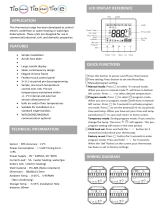4 TP-7141 3/21
4.4 Operation Records ................................................................................................................................................. 57
4.5 Load Management ................................................................................................................................................. 59
4.5.1 Metering, Load Management Overview Screen ....................................................................................... 61
4.5.2 Metering, Load Management, Status ....................................................................................................... 62
4.5.3 Load Management Setup Details ............................................................................................................. 67
Section 5. Setup Menus and Screens .................................................................................................................... 69
5.1 Setup Menus .......................................................................................................................................................... 69
5.1.1 Changing Settings .................................................................................................................................... 69
5.2 Electrical Setup ...................................................................................................................................................... 70
5.2.1 Generator Electrical Setup ....................................................................................................................... 70
5.2.2 Battery Charger Setup Screens ............................................................................................................... 71
5.2.3 Paralleling Setup ...................................................................................................................................... 71
5.3 Engine Setup .......................................................................................................................................................... 72
5.4 Setup, Communication Screen ............................................................................................................................... 74
5.5 Event Configuration ................................................................................................................................................ 76
5.5.1 Generator Set Information (Genset Info) .................................................................................................. 80
5.6 Data Log Screens................................................................................................................................................... 81
Section 6. Paralleling ............................................................................................................................................... 83
6.1 Introduction ............................................................................................................................................................ 83
6.2 Metering ................................................................................................................................................................. 85
6.2.1 Paralleling, Metering, Overview ............................................................................................................... 85
6.2.2 Paralleling, Metering Status ..................................................................................................................... 87
6.2.3 Paralleling, Metering, Details ................................................................................................................... 89
6.2.4 Paralleling, Metering, PGEN .................................................................................................................... 91
6.3 Setup ...................................................................................................................................................................... 92
6.3.1 Paralleling, Setup, PGEN ......................................................................................................................... 92
6.3.2 Paralleling, Setup, Protect Relay Screen ................................................................................................. 94
6.4 Generator Management ......................................................................................................................................... 95
6.4.1 Paralleling, Generator Management Status ............................................................................................. 97
6.4.2 Gen Management Modes......................................................................................................................... 98
6.4.3 Gen Management System Status, Generator .......................................................................................... 99
6.4.4 Paralleling, Gen Management, Setup Details ........................................................................................ 101
Section 7. Remote Monitoring Display, Tier 4 Only ............................................................................................ 103
7.1 Menu Screen ........................................................................................................................................................ 104
7.1.1 Overview ................................................................................................................................................ 105
7.1.2 Fuel ........................................................................................................................................................ 106
7.1.3 Temperature .......................................................................................................................................... 107
7.1.4 Pressure................................................................................................................................................. 109
7.1.5 Aftertreatment ........................................................................................................................................ 110
7.1.6 Display Settings ..................................................................................................................................... 112
Section 8. Troubleshooting ................................................................................................................................... 113
8.1 Introduction .......................................................................................................................................................... 113
8.2 Generator Set and Controller ............................................................................................................................... 113
8.3 Engine .................................................................................................................................................................. 113
8.4 Transfer Switch .................................................................................................................................................... 113
8.5 General Troubleshooting Chart ............................................................................................................................ 114
8.6 Controller Display and Voltage Regulation Troubleshooting Chart ....................................................................... 118
Section 9. Accessories .......................................................................................................................................... 119
9.1 Battery Chargers .................................................................................................................................................. 120
9.2 Input/Output (I/O) Modules ................................................................................................................................... 120
9.2.1 Digital I/O Module .................................................................................................................................. 121
9.3 Manual Key Switch ............................................................................................................................................... 123























